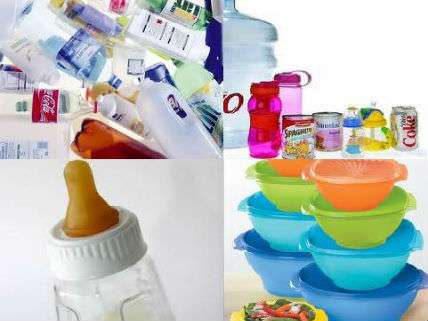BPA Safe: Yet Another Scientifically Unfounded Environmentalist Scare Bites the Dust
European Food Safety Authority finds "no consumer health risk from bisphenol-A exposure."

The hyper-precautionary European Food Safety Authority (EFSA) just issued a comprehensive analysis of the safety of dietary exposures to bisphenol-A (BPA) that finds "no consumer health risk from bisphenol-A exposure." BPA is a compound that is used to soften various plastics including those in water bottles and the linings of canned food containers. For years, environmental activists have been pushing the scientifically dubious low-dose endocrine disruptor hypothesis in which trace exposures to some synthetic chemicals deleteriously upsets the balance of sex hormones in the human body. Among other things, endocrine disruption due to exposure to synthetic chemicals supposedly causes lower sperm counts, deformed penises, and early breast development in girls.
Not so, says the EFSA. The agency's press release states:
EFSA's comprehensive re-evaluation of bisphenol A (BPA) exposure and toxicity concludes that BPA poses no health risk to consumers of any age group (including unborn children, infants and adolescents) at current exposure levels. Exposure from the diet or from a combination of sources (diet, dust, cosmetics and thermal paper) is considerably under the safe level (the "tolerable daily intake" or TDI).
The accompanying fact sheet notes:
BPA poses no health risk to consumers because current exposure to the chemical is too low to cause harm.
Based on new data and methodologies, EFSA has lowered the estimated safe level, known as the tolerable daily intake (TDI), to 4 micrograms per kilogram of body weight per day. This is twelve and a half times lower than the previous level.
The highest estimates for aggregated exposure to BPA from both dietary and non-dietary sources are 3 to 5 times lower than the TDI—depending on the age group.
Dietary exposure is from 4 to 15 times lower than previously estimated by EFSA, depending on the age group.
The EFSA determined the new safe level (TDI) by multiplying the old human exposure standard by six yielding a highly precautionary overall uncertainty factor of 150—basically lowering the exposure threshold 150-fold below the Lowest-Observed-Adverse-Effect-Level in animal toxicology experiments.
The low-dose endocrine disruptor hypothesis is a chemical scare launched in the mid-1990s by would-be Rachel Carsons in the alarmist book, Our Stolen Future: Are We Threatening Our Fertility, Intelligence, and Survival?-A Scientific Detective Story.
In December 2013, a comprehensive review of low-dose endocrine disruptors by researchers published in Toxicology Letters tartly concluded:
Taking into account the large resources spent on this topic, one should expect that, in the meantime, some EDs [endocrine disruptors] that cause actual human injury or disease should have been identified. However, this is not the case. To date, with the exception of natural or synthetic hormones [e.g., contraceptive pills and DES], not a single, man-made chemical ED has been identified that poses an identifiable, measurable risk to human health (the adverse effects of iatrogenic DES were long known before the term endocrine disruptor was coined). Certainly, there has been much media hype about imaginary health risks from bisphenol A, parabens or phthalates. However, no actual evidence of adverse human health effects from these substances has ever been established. To the contrary, there is increasing evidence that their health risks are absent or negligible – or imaginary.
Given that there is essentially no evidence for the ubiquity of low-dose endocrine disruption, why is it still an issue for activists? The researchers note:
The hypothesis of and subsequent search for man-made (synthetic), chemical EDs in the environment, food or personal care products began in the early 1990s. Up to date, this research has spent hundreds of millions of Euros or Dollars of tax payer's money. In the EU alone, more than 150 million Euros have been spent on research into potential health risks of EDCs (Jensen and van Vliet, 2012). Given this large amount of research funding there may also be a vested interest of scientists in the ED field to keep the ED hypothesis on the agenda in order to stay in business.
To its credit the U.S. Food and Drug Administration (FDA) has refused to give into the scaremongering over BPA:
FDA acknowledges the interest that many consumers have in BPA. FDA has performed extensive research and reviewed hundreds of studies about BPA's safety. We reassure consumers that current approved uses of BPA in food containers and packaging are safe.
Sadly, evidence rarely changes the minds of activists, so we can expect to see billions more wasted on research and regulation of low-dose endocrine disruptors.


Show Comments (34)